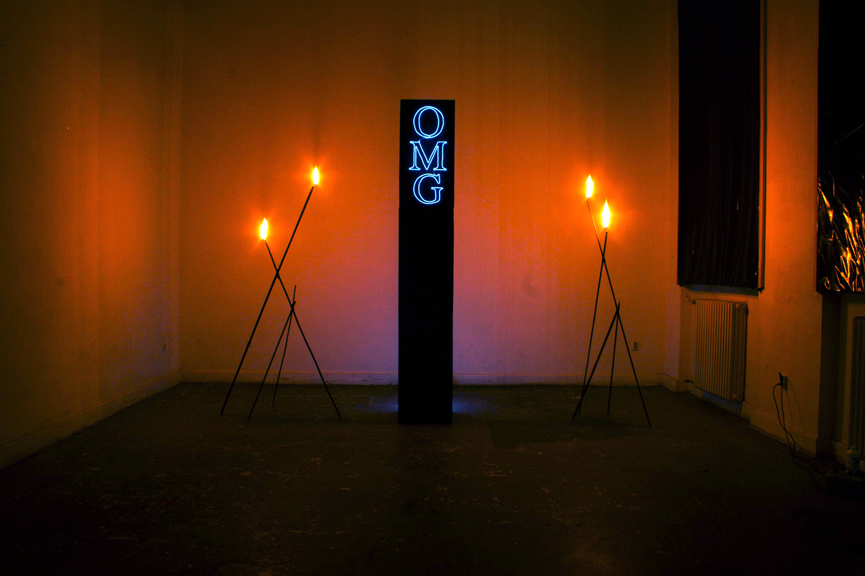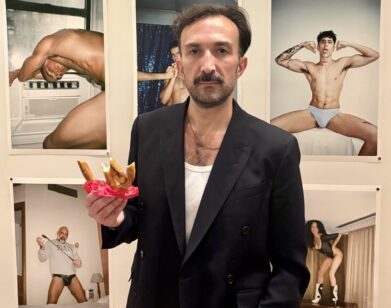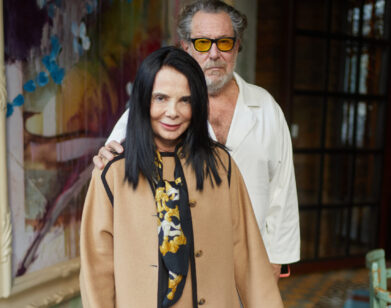AIDS-3D in Real Life

OMG Obelisk, 2007. Courtesy the artists.
Born in 1986, AIDS-3D (Daniel Keller and Nik Kosmas) are the youngest participants in the New Museum’s Generational. The duo, who live in Berlin but are from Detroit and Minneapolis, respectively, make mixed media and often web-related works that relate to viewers in an immersive, often disturbing way. Tellingly, they prefer to leave their provocative pseudonym a mystery. A forthcoming exhibition in Istanbul is tentatively titled “Omega Point,” defined by Wikipedia as “a maximum level of complexity… towards which the universe is evolving.” Wikipedia is of course an example of just such a point, and the type of metaphor that the New Museum will look to elaborate with the Younger Than Jesus survey.
AIDS-3D haven’t yet had shows official enough to show up on Artfacts—if that’s any measure of success. But they have showed up on blogs and myspaces worldwide. At the New Museum exhibition they will show OMG Obelisk, which is best known as a cheaply animated .gif file. It was originally shown in foam, and the fires didn’t stay lit; at the New Museum it be cast in a relatively monumental MDF.
ALEX GARTENFELD: So you just heard about the announcement through me? That can’t be true; people have known for weeks.
DANIEL KELLER: I knew I was in the show. But I woke up and your email was the first thing I heard about the announcement.
AG: I hope it was a nice surprise! How did the curators find you—through the Internet?
DK: In essence, yes. Most people we meet we meet online first, but I think Aleksandra [Domanovic] from VVORK or Ceci [Moss] from Rhizome were some of the informants.”
AG: You’re showing the OMG Obelisk. I thought that only existed as a .gif file. I thought most of your work did.
DK: No it was an installation, and it will be re-staged there, although yes, it’s mostly known in its animated .gif form. We installed it at the Rundgang at UDK in Berlin in the summer of 2007, but it was highly ephemeral. It was made with duct tape, and the fire lasted for only a few minutes at a time.
AG: Do you prefer it in one way or another?
DK: I think that it’s essential that the piece has two existences. I like that the piece has a digital , phenomenonal existence and then a sorta downloaded, shittier real form. That it can be translated.
AG: Do you say OMG in real life a lot? I’ve never noticed…
DK: I don’t really say “OMG” very much, but in chats, it’s unavoidable. But I like it because of its ubiquity. But the obelisk is also intended to be an icon, and a monument. “OMG” denotes very mild shock, or an overreaction.
AG: The press blast by the New Museum announcing the included artists was titled “OMG.” It came off as ironic, and self-effacing, if not referring to your piece.
DK: Was it really called that? Sure it’s self-effacing, because of its honesty. A generational might be self-fulfilling, because of the New Museum’s institutional clout. And well, I hope so, because we are so broke.
AG: [LAUGHS] That’s OK in Berlin though, right?
DK: That’s a myth about Berlin. Making stuff is expensive anywhere, and almost all of our stuff is real first.
AG: But a decent quality of life is less expensive, presumably.
DK: We have a nice big cheap studio and nice houses nearby and the public transportation is great. But even the tape we use to put up our EL-wire pieces adds up, or X-acto blades. The only thing cheap is making digital work on pirated software. Berlin is cheaper than other cities, but being an artist that makes real objects requires financial support.
AG: Why did you go there?
DK: It’s just a really nice livable functional city, which Chicago was not. We really wanted to get out of America, and from the Art Institute in Chicago specifically, so we did an exchange program.
AG: And you stayed?
DJ: We were supposed to be there for two semesters at the Staedelschule. But the class we took was completely dysfunctional, so it pushed us to be more independent. It was unbelievably smoky in the classroom, which we only attended once a month. People talked about nothing, and made nothing. They were amazed because we managed to bring in some piece of shit every two months. I think our hyper-productivity is very American, and this city at this point in time happens to be a good place to grow.
AG: There are so many galleries, in Mitte and in Kreuzberg.
DK: Yeah but we don’t feel very connected to that. Most of our events have bee international. And I mean, we’ve never had an exhibition in a proper commercial gallery.
AG: I first saw your work in a mutual friend’s storefront.
DK: We started doing a lot of site-specific installations at clubs or storefronts, which allowed us to make photographs of work, which went on the website. Somehow it really worked as a beacon. We get a lot of traffic because people use our image collection for myspace comments and stuff.
AG: Can an obelisk be monumental if it’s on the web? This interview is for the web!
DK: Sure, like the Dancing Baby.
AG: Isn’t that kitsch?
DK: Well so are monuments sometimes. They remain as evidence of their time, and plenty of ideas become relevant again later. Kitsch is like purgatory.
AG: What would be the perfect monument?
DK: The Matrix, a totally simulated experience—a piece that used that type of technology, or simulates an experience totally convincingly. Films are certainly immersive, and sculptural installations, and of course video games, but I don’t think they have universal appeal. Not yet.
AG: What’s your “dream piece?”
DK: It would be a fully designed space with animatronic robot-drama interactive installation/theater.
The New Museum’s Younger Than Jesus opens April 8.






